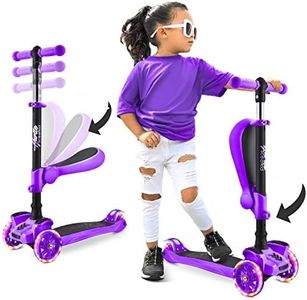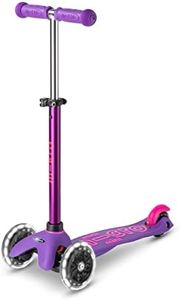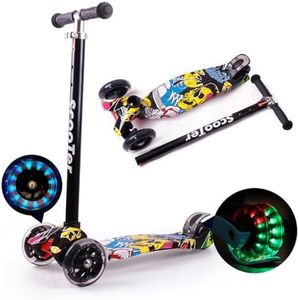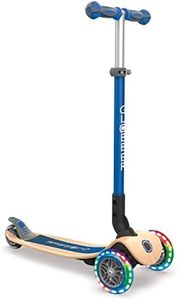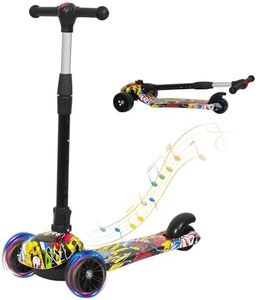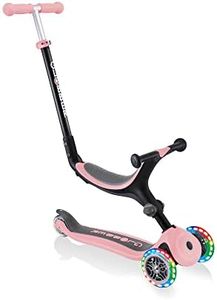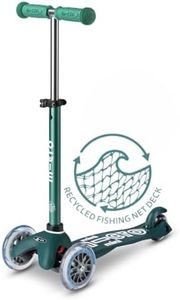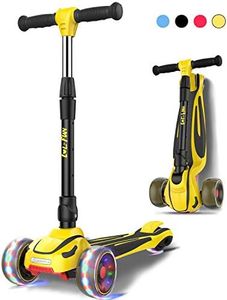We Use CookiesWe use cookies to enhance the security, performance,
functionality and for analytical and promotional activities. By continuing to browse this site you
are agreeing to our privacy policy
10 Best 3 Wheel Scooter For Kids
From leading brands and best sellers available on the web.Buying Guide for the Best 3 Wheel Scooter For Kids
Choosing a 3-wheel scooter for kids is a fun process, but it’s important to keep a few things in mind to make sure you’re picking something safe, comfortable, and appropriate for your child’s age and abilities. Instead of just going for the prettiest scooter, think about features that will help your child ride easily and stay safe. Focusing on the core aspects of how the scooter works and how your child might use it can help you select the very best fit.Age and Weight RecommendationThis spec tells you for what ages and weight range the scooter is designed. It's crucial because using a scooter meant for older or heavier children could be unsafe for a lighter, younger child, and vice versa. Usually, scooters are divided for toddlers (about 2-5 years), young kids (5-8 years), or even slightly older children. Check your child's age and weight to see where they fit in the suggested range—if your child is on the border, always go for a scooter that gives some growing room while still being easy to control.
Handlebar Height and AdjustabilityHandlebar height affects comfort and control. Adjustable handlebars can move up or down to fit your child as they grow, which means the scooter can be used longer. Fixed-height handlebars might be okay if your child is at just the right size, but adjustable bars are better for growing kids. To pick the best one, have your child stand straight—ideally, the handlebar should be about waist-high, allowing a slight bend in the elbows.
Wheel Size and MaterialThe wheels’ size and what they’re made of affects how smoothly the scooter rolls and how easily it handles bumps or cracks. Smaller wheels (around 100mm) make the scooter lighter and more manageable for little kids on smooth surfaces, while larger wheels (120-150mm) can handle rougher ground but might be heavier. Soft wheels (like polyurethane) give a comfier ride, while hard plastic might feel bumpier. Think about where your child will ride the scooter most—if it’s mostly sidewalks and parks, medium to large wheels in softer material are a good match.
Deck Size and GripThe deck is the part your child stands on. A wider, longer deck gives more stability, which is great for beginners or younger kids, but might feel heavy for older, experienced riders who like to move faster. The deck’s grip (like rubber or special textures) is also important to keep little feet from slipping. If your child is just starting, prioritize a wide deck with good grip.
Steering MechanismMost 3-wheel scooters use 'lean-to-steer', which means your child leans their body to turn. This helps develop balance but takes some getting used to. Others have a twisting handlebar to steer, which might feel familiar to kids used to bikes. For most younger kids or complete beginners, lean-to-steer is safer and encourages building coordination. Consider your child’s confidence and preferences when choosing.
Portability and WeightThe scooter’s weight and whether it folds up makes a big difference for parents who need to carry or transport it. Lightweight scooters are easier for very young kids to handle and for adults to carry when not in use. If you travel a lot or need to store the scooter, look for one with a easy-to-use folding mechanism. If your child will be handling it on their own, make sure it's not too heavy for them.
Brake TypeScooters usually have a rear foot brake where your child steps down to slow or stop. It should be easy to press and respond quickly. Some brakes are metal, which last longer, while plastic ones may be smoother but wear down faster. Try to match the brake type to your child’s strength—make sure they can press it comfortably and stop quickly on their own.
